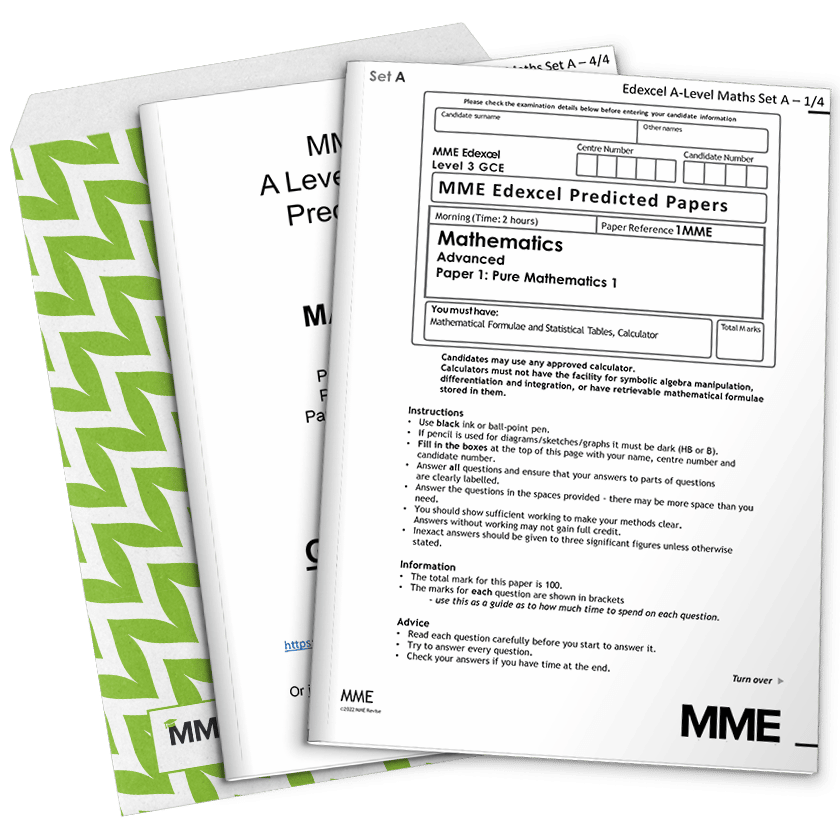Implicit Differentiation
Implicit Differentiation Revision
Implicit Differentiation
An implicit relation between x and y is one written as f(x,y)=g(x,y). They often appear for relations that it is impossible to write in the form y=f(x). Despite not having a nice expression for y in terms of x, we can still differentiate implicit relations.
Method for Implicit Differentiation
To carry out implicit differentiation, follow these steps.
Step 1: Differentiate terms that are in x only.
Step 2: Use the chain rule to differentiate terms in y only.
\dfrac{d}{dx}(f(y))=\dfrac{d}{dy}(f(y))\dfrac{dy}{dx}
This is the same as differentiating f(y) normally then multiplying by \dfrac{dy}{dx}.
Step 3: Use the product rule for terms that are in both x and y.
\dfrac{d}{dx}(u(x)v(y))=u(x)\dfrac{d}{dx}(v(y))+v(y)\dfrac{d}{dx}(u(x))
And you can use the rule in step 2 to find \dfrac{d}{dx}(v(y)).
Step 4: Rearrange the resulting equation to make \dfrac{dy}{dx} the subject.
Finding the Gradient with Implicit Differentiation
Implicit differentiation still finds the gradient. We can calculate the gradient at a given x value by finding the y value from the equation for the curve then finding \dfrac{dy}{dx} at these values of x and y.
We can also find other things, such as an equation linking x and y at stationary points: \dfrac{dy}{dx}=0.
Example: A curve is defined by y^{2}-3xy+x^{2}=0. Find the gradient at all points where x=2.
y^{2}-3xy+x^{2}=0Implicitly differentiate:
2y\dfrac{dy}{dx}-3x\dfrac{dy}{dx}-3y+2x=0
Rearrange:
(2y-3x)\dfrac{dy}{dx}-3y+2x=0
\dfrac{dy}{dx}+\dfrac{2x-3y}{2y-3x}=0
\dfrac{dy}{dx}=\dfrac{3y-2x}{2y-3x}
Substitute x value into curve to find y values:
At x=2, y^{2}-6y+4=0
y=\dfrac{-(-6)\pm\sqrt{(-6)^{2}-4\times1\times4}}{2\times1}
y=\dfrac{6\pm\sqrt{36-16}}{2}
y=3\pm\dfrac{\sqrt{20}}{2}
y=3\pm\sqrt{5}
Substitute x,y values into \dfrac{dy}{dx}:
|
y=3+\sqrt{5} \dfrac{dy}{dx}=\dfrac{3(3+\sqrt{5})-2\times2}{2(3+\sqrt{5})-3\times2} \dfrac{dy}{dx}=\dfrac{9+3\sqrt{5}-4}{6+2\sqrt{5}-6} \dfrac{dy}{dx}=\dfrac{5+3\sqrt{5}}{2\sqrt{5}} \dfrac{dy}{dx}=\dfrac{5\sqrt{5}+15}{10} \dfrac{dy}{dx}=\dfrac{3+\sqrt{5}}{2} |
y=3-\sqrt{5} \dfrac{dy}{dx}=\dfrac{3(3-\sqrt{5})-2\times2}{2(3-\sqrt{5})-3\times2} \dfrac{dy}{dx}=\dfrac{9-3\sqrt{5}-4}{6-2\sqrt{5}-6} \dfrac{dy}{dx}=\dfrac{5-3\sqrt{5}}{-2\sqrt{5}} \dfrac{dy}{dx}=\dfrac{5\sqrt{5}-15}{-10} \dfrac{dy}{dx}=\dfrac{3-\sqrt{5}}{2} |
Hence, gradients at x=2 are \dfrac{3+\sqrt{5}}{2} and \dfrac{3-\sqrt{5}}{2}
Differentiating the Inverse Trigonometric Functions
Implicit differentiation is how we find the derivative of \arcsin, \arccos and arctan.
Example: Find the derivative of \arcsin(x).
y=\arcsin(x)Take \sin of both sides:
\sin(y)=xDifferentiate (implicitly):
\cos(y)\dfrac{dy}{dx}=1
\dfrac{dy}{dx}=\dfrac{1}{\cos(y)}
\dfrac{dy}{dx}=\dfrac{1}{\sqrt{\cos^{2}(y)}}
We know that \sin^{2}(y)+\cos^{2}(y)=1, so \cos^{2}(y)=1-\sin^{2}(y)
\dfrac{dy}{dx}=\dfrac{1}{\sqrt{1-\sin^{2}(y)}}Now x=\sin(y) so we can put this back into the equation.
\dfrac{dy}{dx}=\dfrac{1}{\sqrt{1-x^{2}}}
Example 1: Implicit Differentiation
4x^{3}+23\sin(x)\cos(y)+36xy^{2}+12y+1=0. Find \dfrac{dy}{dx}.
[3 marks]
4x^{3}+23\sin(x)\cos(y)+36xy^{2}+12y+1=0Differentiate implicitly.
12x^{2}+23\cos(x)\cos(y)-23\sin(x)\sin(y)\dfrac{dy}{dx}+36y^{2}+72xy\dfrac{dy}{dx}+12\dfrac{dy}{dx}=0
12x^{2}+23\cos(x)\cos(y)+36y^{2}=23\sin(x)\sin(y)\dfrac{dy}{dx}-72xy\dfrac{dy}{dx}-12\dfrac{dy}{dx}
12x^{2}+23\cos(x)\cos(y)+36y^{2}=(23\sin(x)\sin(y)-72xy-12)\dfrac{dy}{dx}
\dfrac{dy}{dx}=\dfrac{12x^{2}+23\cos(x)\cos(y)+36y^{2}}{23\sin(x)\sin(y)-72xy-12}
Example 2: Inverse Trigonometric Functions
Find the derivative of \arccos(x).
[4 marks]
y=\arccos(x)Take \cos of both sides.
\cos(y)=xImplicitly differentiate.
-\sin(y)\dfrac{dy}{dx}=1
\dfrac{dy}{dx}=-\dfrac{1}{\sin(y)}
\dfrac{dy}{dx}=-\dfrac{1}{\sqrt{\sin^{2}(y)}}
We know \sin^{2}(y)+\cos^{2}(y)=1, so \sin^{2}(y)=1-\cos^{2}(y)
\dfrac{dy}{dx}=-\dfrac{1}{\sqrt{1-\cos^{2}(y)}}Now x=\cos(y) so we can put this back into the equation.
\dfrac{dy}{dx}=-\dfrac{1}{\sqrt{1-x^{2}}}
Implicit Differentiation Example Questions
Question 1: A curve is 9\ln(x)\cos(y)=0. Find \dfrac{dy}{dx}.
[2 marks]
Differentiate implicitly:
\dfrac{9\cos(y)}{x}-9\ln(x)\sin(y)\dfrac{dy}{dx}=0
\dfrac{9\cos(y)}{x}=9\ln(x)\sin(y)\dfrac{dy}{dx}=0
\dfrac{dy}{dx}=\dfrac{9\cos(y)}{9x\ln(x)\sin(y)}
\dfrac{dy}{dx}=\dfrac{\cos(y)}{x\ln(x)\sin(y)}
Question 2: Find the gradient of the curve 3x^{2}y-x=0 when x=\dfrac{1}{3}
[3 marks]
Differentiate implicitly.
6xy+3x^{2}\dfrac{dy}{dx}-1=0
3x^{2}\dfrac{dy}{dx}=1-6xy
\dfrac{dy}{dx}=\dfrac{1-6xy}{3x^{2}}
Find y when x=\dfrac{1}{3}.
3\left(\dfrac{1}{3}\right)^{2}y-\dfrac{1}{3}=0
3\times\dfrac{1}{9}y-\dfrac{1}{3}=0
\dfrac{1}{3}y-\dfrac{1}{3}=0
\dfrac{1}{3}y=\dfrac{1}{3}
y=1
Substitute into our expression for \dfrac{dy}{dx}:
\dfrac{dy}{dx}=\dfrac{1-6\times1\times\dfrac{1}{3}}{3\left(\dfrac{1}{3}\right)^{2}}
\dfrac{dy}{dx}=\dfrac{1-2}{3\times\dfrac{1}{9}}
\dfrac{dy}{dx}=\dfrac{-1}{\dfrac{1}{3}}
\dfrac{dy}{dx}=-3
So the gradient is -3 at this point.
Question 3:
a) Find the implicit derivative of 3x^{3}y^{2}-xy=1
b) Find an equation linking x and y at the stationary points of the curve.
c) Use this equation and the equation of the curve to find the stationary points of the curve.
[8 marks]
a) 3x^{3}y^{2}-xy=1
9x^{2}y^{2}+6x^{3}y\dfrac{dy}{dx}-y-x\dfrac{dy}{dx}=0
9x^{2}y^{2}-y=x\dfrac{dy}{dx}-6x^{3}y\dfrac{dy}{dx}
9x^{2}y^{2}-y=(x-6x^{3}y)\dfrac{dy}{dx}
\dfrac{dy}{dx}=\dfrac{9x^{2}y^{2}-y}{x-6x^{3}y}
b) Stationary point is at \dfrac{dy}{dx}=0
0=\dfrac{9x^{2}y^{2}-y}{x-6x^{3}y}
9x^{2}y^{2}-y=0
y(9x^{2}y-1)=0
y=0 or 9x^{2}y-1=0
y=0 or 9x^{2}y=1
c) Curve equation is 3x^{3}y^{2}-xy=1
y=0 gives 0=1 so we cannot use this result.
9x^{2}y=1
y=\dfrac{1}{9x^{2}}
Substitute this into the curve.
3x^{3}\left(\dfrac{1}{9x^{2}}\right)^{2}-\dfrac{x}{9x^{2}}=1
\dfrac{3x^{3}}{81x^{4}}-\dfrac{1}{9x}=1
\dfrac{1}{27x}-\dfrac{1}{9x}=1
1-3=27x
x=-\dfrac{2}{27}
y=\dfrac{1}{9x^{2}}
y=\dfrac{1}{9\left(-\dfrac{2}{27}\right)^{2}}
y=\dfrac{1}{9\left(\dfrac{4}{729}\right)}
y=\dfrac{1}{\left( \dfrac{4}{81}\right) }
y=\dfrac{81}{4}
So the stationary point is \left(-\dfrac{2}{27},\dfrac{81}{4}\right)
Question 4: Find the derivative of y=\arctan(x).
[3 marks]
Take \tan of both sides.
\tan(y)=x
Differentiate implicitly:
\sec^{2}(y)\dfrac{dy}{dx}=1
\dfrac{dy}{dx}=\dfrac{1}{\sec^{2}(y)}
Identity: \sec^{2}(y)=1+\tan^{2}(y)
\dfrac{dy}{dx}=\dfrac{1}{1+\tan^{2}(y)}
Put x=\tan(y) back into the equation.
\dfrac{dy}{dx}=\dfrac{1}{1+x^{2}}
You May Also Like...

MME Learning Portal
Online exams, practice questions and revision videos for every GCSE level 9-1 topic! No fees, no trial period, just totally free access to the UK’s best GCSE maths revision platform.







